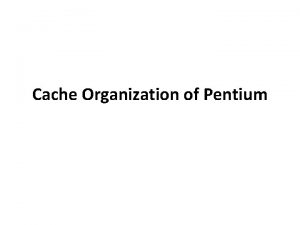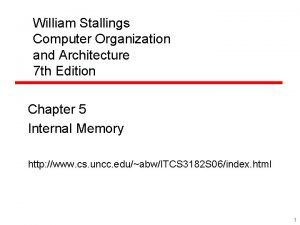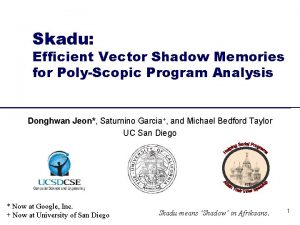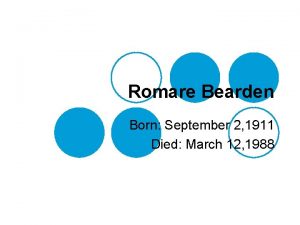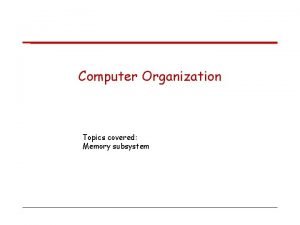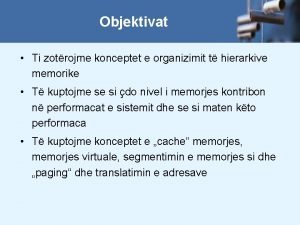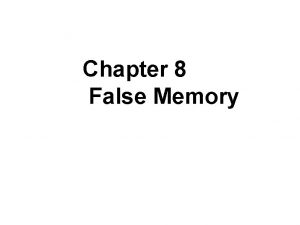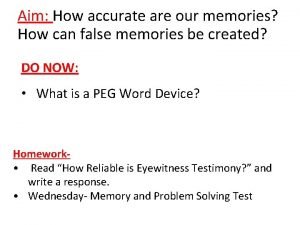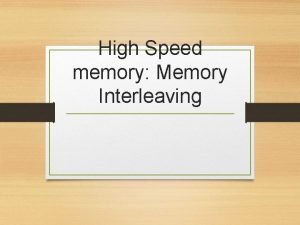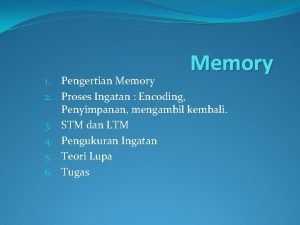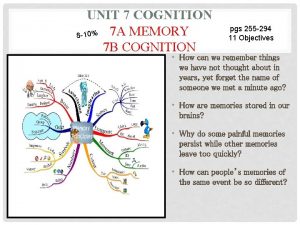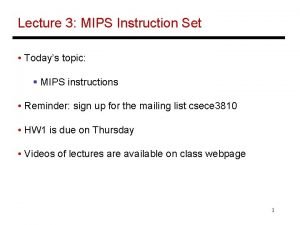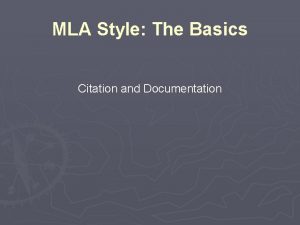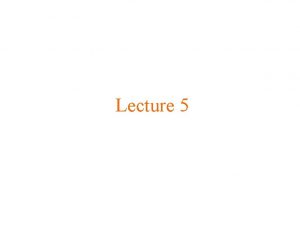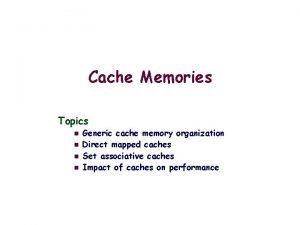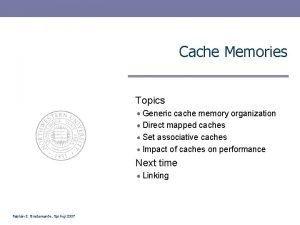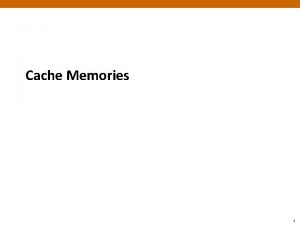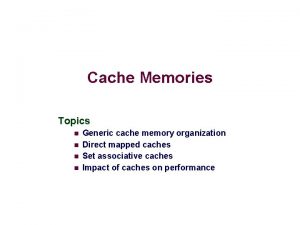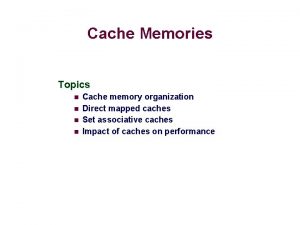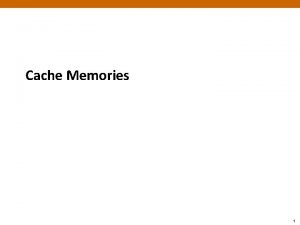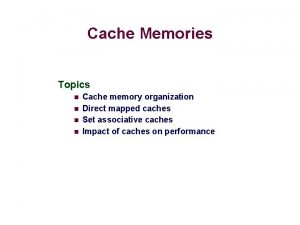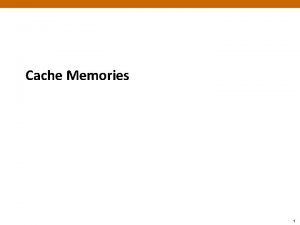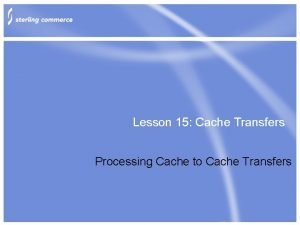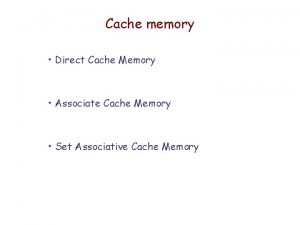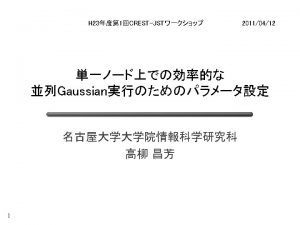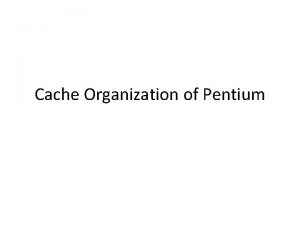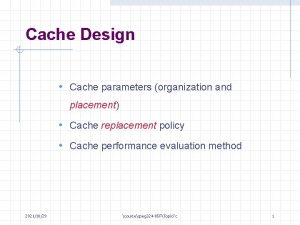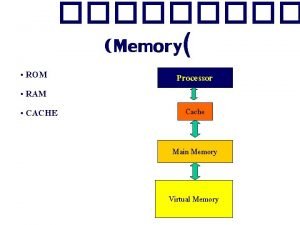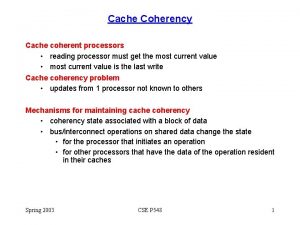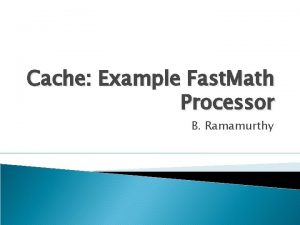Lecture 5 Todays lecture Processor Selfscheduling Cache memories










































![The results for (i=0; i<N; i++) for (j=0; j<N; j++) a[i][j] += b[i][j]; 0 The results for (i=0; i<N; i++) for (j=0; j<N; j++) a[i][j] += b[i][j]; 0](https://slidetodoc.com/presentation_image_h2/0e0417b4b05a40353898f06a82444f1e/image-43.jpg)
- Slides: 43

Lecture 5

Today’s lecture • Processor Self-scheduling • Cache memories Scott B. Baden / CSE 160 / Wi '16 2

Non-uniform workloads • In the Mandelbrot set assignment, some points take longer to complete than others, so the work is not uniformly distributed • A block cyclic decomposition can balance the workload: core k gets strips starting at rows CHUNK*k, CHUNK*k+1*NT*CHUNK, CHUNK*k+2*NT*CHUNK, … • Core 1 gets strips@ 2*1, 2+1*2*3, 2+2*2*3 2 NT=3 CHUNK=2 8 14 Scott B. Baden / CSE 160 / Wi '16 3

Second approach: dynamic scheduling • Block cyclic decomposition is a static method • The workload assignment can’t respond to the workload distribution: it is the same for all • Problem: what if the workload distribution correlates with the block cyclic thread assignment? • Processor self scheduling: threads pick up work dynamically, on demand, with a chunk size NT=2 CHUNK=2 Scott B. Baden / CSE 160 / Wi '16 4

How does self scheduling work? Self. Scheduler S(n, NT, Chunk); h=1/(n-1) while ( S. get. Chunk(start. Row)) for i = start. Row to start. Row+ Chunk - 1 for j = 0; j < n; j++ z=complex(i*h, j*h) do end for end while z = z 2 + c while (|z| < 2 ) Scott B. Baden / CSE 160 / Wi '16 5

Implementation • We increment a counter inside a critical section • OMP and C++ implementations • _counter is a protected member of Self. Scheduler boolean get. Chunk(int& start. Row){ Begin critical section k = _counter; _counter += _chunk; End critical section if ( k > (_n – _chunk) return false; start. Row= k; return true; } Scott B. Baden / CSE 160 / Wi '16 6

Tradeoffs in dynamic scheduling • Dynamic workload assignments • Each thread samples a unique (and disjoint) set of indices, changes from run to run • A shared counter or work queue represents the work • User tunes work granularity (chunk size) trading off the overhead of workload assignment against increased load imbalance Finest granularity: each point is a separate task Coarsest granularity: one block per processor High overheads Increasing Load imbalance Running time Increasing granularity Scott B. Baden / CSE 160 / Wi '16 7

When might decreasing the chunk size hurt performance? A. We will hand out more chunks of work B. Data from adjacent rows is less likely to reside in cache C. The workloads will be balanced less evenly D. A & B E. B & C Scott B. Baden / CSE 160 / Wi '16 8

When might decreasing the chunk size hurt performance? A. We will hand out more chunks of work B. Data from adjacent rows is less likely to reside in cache C. The workloads will be balanced less evenly D. A & B E. B & C Scott B. Baden / CSE 160 / Wi '16 9

Iteration to thread mapping with block cyclic for (i = 0; i < N; i++) iters[i] = thread assigned to row i N = 9, # of threads = 3 (BLOCK) 0 0 0 1 1 1 2 22 N = 16, # threads = 4, BLOCK CYCLIC(Chunk = 2) 00112233 N=9, # threads = 3, BLOCK CYCLIC(Chunk = 2) 0 0 1 1 2 2 0 01 Scott B. Baden / CSE 160 / Wi '16 10

Which are plausible dynamic assignments of iterations to threads with, N=16, NT=4, Chunk=2 A. B. C. D. E. 330011223333 2332001122223321 2233001122220022 A&B A&C while ( S. get. Chunk(startrow)) iters[start. Row: start. Row+NT-1] = Thread ID(); Scott B. Baden / CSE 160 / Wi '16 11

Which are plausible dynamic assignments of iterations to threads with, N=16, NT=4, Chunk=2 A. B. C. D. E. 330011223333 2332001122223321 2233001122220022 A&B A&C while ( S. get. Chunk(startrow)) iters[start. Row: start. Row+NT-1] = Thread ID(); Scott B. Baden / CSE 160 / Wi '16 12

Today’s lecture • Processor Self-scheduling • Cache memories Scott B. Baden / CSE 160 / Wi '16 13

The processor-memory gap • Difference in processing and memory speeds growing exponentially over time • The result of technological trends http: //www. extremetech. com (see http: //tinyurl. com/ohmbo 7 y) Scott B. Baden / CSE 160 / Wi '16 14

An important principle: locality • Memory accesses exhibit two forms of locality Processor likely to access a location again in the near future (Temporal locality (time)) Processor likely to access a location nearby to the current acces (Spatial locality (space)) • Often involves loops • Opportunities for reuse for t=0 to T-1 for i = 1 to N-2 u[i]=(u[i-1] + u[i+1])/2 Scott B. Baden / CSE 160 / Wi '16 15

Which of these loops exhibit spatial locality? A. for i = 1 to N-2 u[i]=(u[i-1] + u[i+1])/2 B. for i = N-2 to 1 by -1 u[i]=(u[i-1] + u[i+1])/2 C. for i = 1 to N-2 by 1024 u[i]=(u[i-1] + u[i+1])/2 D. for i = 1 to N-2 by 1024 u[J[i]]= sqrt((u[J[i]]) E. None of them do Scott B. Baden / CSE 160 / Wi '16 16

Which of these loops exhibit spatial locality? A. for i = 1 to N-2 u[i]=(u[i-1] + u[i+1])/2 B. for i = N-2 to 1 by -1 u[i]=(u[i-1] + u[i+1])/2 C. for i = 1 to N-2 by 1024 u[i]=(u[i-1] + u[i+1])/2 D. for i = 1 to N-2 by 1024 u[J[i]]= sqrt((u[J[i]]) E. None of them do Scott B. Baden / CSE 160 / Wi '16 17

Memory hierarchies • Enable reuse through a hierarchy of smaller but faster memories • Put things in faster memory that we re-use frequently 1 CP (1 word) CPU 32 to 64 KB 256 KB to 4 MB GB Many GB or TB L 1 L 2 DRAM Disk Scott B. Baden / CSE 160 / Wi '16 2 -3 CP (10 to 100 B) O(10) CP (10 - 100 B) O(100) CP O(106) CP 18

Bang’s Memory Hierarchy • Intel “Clovertown” processor • Intel Xeon E 5355 (Introduced: 2006) • Two “Woodcrest” dies (Core 2) on a multichip module • Two “sockets” • techreport. com/articles. x/10021/2 Intel 64 and IA-32 Architectures Optimization Reference Manual, Tab 2. 16 Line Size = 64 B (L 1 and L 2) Access latency, throughput (clocks) 3, 1 14*, 2 150/600 Core 2 Core 2 32 K L 1 32 K L 1 4 MB Shared L 2 http: //goo. gl/Qxv. SVr FSB 10. 66 GB/s Chipset (4 x 64 b controllers) 21. 3 GB/s(read) 8 16 4 MB Shared L 2 FSB 10. 66 GB/s * Will vary depending on access patterns and other factors Associativity 10. 6 GB/s(write ) 667 MHz FBDIMMs Line size (bytes): 64 Write update policy: Writeback Sam Williams et al. Scott B. Baden / CSE 160 / Wi '16 19

How does a cache work? • Organize memory and cache into blocks called lines (typically 64 bytes) • Simplest cache: a direct mapped cache • We map each line in main memory to a unique line in cache: many-to-1 mapping • The first time we access an address within a given line in main memory, we load the line into cache: a cache miss • The next time we access any address within that line, we have a cache hit: we pay the cost of accessing the cache line only, not memory • With a 1 level cache, the miss penalty is more or less the cost of accessing memory Scott B. Baden / CSE 160 / Wi '16 20

The Benefits of Cache Memory • Let say that we have a small fast memory that is 10 times faster (access time) than main memory … • If we find what we are looking for 90% of the time (cache hit rate), access time approaches that of fast memory • Taccess = 0. 90 1 + (1 -0. 9) 10 = 1. 9 • Memory appears to be 5 times faster • We can have multiple levels of cache Scott B. Baden / CSE 160 / Wi '16 21

If our L 1 hit rate is 95%, L 2 hit rate = 99%, what is the effective memory access time on Bang where L 1 hit= 3 CP, L 2 = 12 CP, Memory = 160 CP? A. 0. 95 3 + (1 -0. 95) 0. 99 12 + 0. 05 0. 01 160 = B. 0. 95 3 + 0. 99 12 + (1 -0. 99) 160 = 16. 3 C. Neither Scott B. Baden / CSE 160 / Wi '16 3. 5 22

If our L 1 hit rate is 95%, L 2 hit rate = 99%, what is the effective memory access time on Bang where L 1 hit= 3 CP, L 2 = 12 CP, Memory = 160 CP? A. 0. 95 3 + (1 -0. 95) 0. 99 12 + 0. 05 0. 01 160 = B. 0. 95 3 + 0. 99 12 + (1 -0. 99) 160 = 16. 3 C. Neither Scott B. Baden / CSE 160 / Wi '16 3. 5 23

Direct mapped cache • Look up the line indexed by the line index • Like a hash table: match the stored tag against the higher order address bits selected line Line 0 valid tag cache block Line 1 valid tag cache block • • • t bits m-1 tag s bits 00 001 b bits Line index block offset Line L-1 valid tag cache block 0 The address Randal E. Bryant and David R. O Scott B. Baden / CSE 160 / Wi '16 24

Issues in using a cache • • Where can we place the block? How do we find the block? Which block should we on a miss? What happens on a write? =1? (1) The valid bit must be set 0 selected line (i) 1 2 3 m-1 4 w 0 0110 (2) The tag bits in the cache line must match the tag bits in the address Randal E. Bryant and David R. O’Hallaron 1 5 6 w 1 w 2 7 w 3 =? (3) If (1) and (2) are true: we have a cache hit t bits 0110 tag s bits b bits i 100 Line index block offset 0 The address Scott B. Baden / CSE 160 / Wi '16 23

Why do we use the middle bits for indexing the cache rather than the higher order bits? A. Consecutive memory lines map to different cache lines B. Consecutive memory lines map to same cache entry T bits T tag bits B = 2 b bytes per line per cache block Line 0: Line 1: valid tag 0 1 • • • B– 1 s bits b bits m-1 0 <tag> <line index> <block offset> • • • Line s-1: valid tag 0 Scott B. Baden / CSE 160 / Wi '16 26

Why do we use the middle bits for indexing the cache rather than the higher order bits? A. Consecutive memory lines map to different cache lines B. Consecutive memory lines map to same cache entry T bits T tag bits B = 2 b bytes per line per cache block Line 0: Line 1: valid tag 0 1 • • • B– 1 s bits b bits m-1 0 <tag> <line index> <block offset> • • • Line s-1: valid tag 0 Scott B. Baden / CSE 160 / Wi '16 27

What happens on a write? • Write Through / Write Back Write through to memory Write to cache only – when do we update memory? • Allocate on Write / No Allocate on Write: whether or not we load cache on a miss, or write to main memory only Scott B. Baden / CSE 160 / Wi '16 28

Why might a write-back cache be useful? A. We expect to write to that location several times B. We expect to read from that location several times C. A & B D. Neither A nor B Scott B. Baden / CSE 160 / Wi '16 29

Why might a write-back cache be useful? A. We expect to write to that location several times B. We expect to read from that location several times C. A & B D. Neither A nor B Scott B. Baden / CSE 160 / Wi '16 30

The 3 C’s of cache misses • Compulsory (AKA Cold Start) • Capacity • Conflict Scott B. Baden / CSE 160 / Wi '16 31

What is the cache miss rate we’ll observe if we have an infinite cache? A. Compulsory B. Capacity C. Conflict Scott B. Baden / CSE 160 / Wi '16 32

What is the cache miss rate we’ll observe if we have an infinite cache? A. Compulsory B. Capacity C. Conflict Scott B. Baden / CSE 160 / Wi '16 33

Other cache design issues • Separate Instruction (I) and Data (D) • Unified (I+D) • Last Level Cache (LLC) – the slowest cache (furthest away from the processor) • Translation Lookaside Buffer (TLB) L 2 Processor Regs TLB L 1 d-cache L 1 i-cache L 3 Cache (LLC) Memory Unified L 2 Cache Scott B. Baden / CSE 160 / Wi '16 34

Two main types of caches • Direct mapped • Set Associative Block placement Eviction policy on a miss/write Scott B. Baden / CSE 160 / Wi '16 35

Set associative cache • More than 1 line per set • Search each valid line for matching tag bits • Miss/write: evict the least recently used (LRU) 1 valid bit per line set 0: set 1: T tag bits B = 2 b bytes per line per cache block tag 0 1 • • • B– 1 valid tag • • • 0 1 • • • B– 1 valid tag 0 1 • • • B– 1 1 • • • B– 1 valid • • • T bits s bits b bits m-1 0 <tag> <set index> <block offset> • • • valid set S-1: valid tag 0 tag • • • 0 1 • • • B– 1 Randal E. Bryant and David R. O’Hallaron Scott B. Baden / CSE 160 / Wi '16 36

Examining Bang’s Memory Hierarchy • /proc/cpuinfo summarizes the processor vendor_id : Genuine. Intel model name : Intel(R) Xeon(R) CPU E 5345 @2. 33 GHz cache size : 4096 KB cpu cores : 4 • processor : 0 through processor Core 2 Core 2 32 K L 1 32 K L 1 4 MB Shared L 2 FSB 10. 66 GB/s : 7 FSB 10. 66 GB/s Scott B. Baden / CSE 160 / Wi '16 37

Detailed memory hierarchy information • /sys/devices/system/cpu*/cache/index*/* • Login to bang and view the files Core 2 Core 2 32 K L 1 32 K L 1 4 MB Shared L 2 FSB 10. 66 GB/s Scott B. Baden / CSE 160 / Wi '16 38

How can we improve cache performance? A. Reduce the miss rate B. Reduce the miss penalty C. Reduce the hit time D. A, B and C Scott B. Baden / CSE 160 / Wi '16 39

How can we improve cache performance? A. Reduce the miss rate B. Reduce the miss penalty C. Reduce the hit time D. A, B and C Scott B. Baden / CSE 160 / Wi '16 40

Optimizing for re-use • The success of caching depends on the ability to re-use previously cached data • Data access order affects re-use • Assume a cache with 2 entries, each 2 words wide for (i=0; i<N; i++) for (j=0; j<N; j++) a[i][j] += b[i][j]; 0 1 4 5 for (j=0; j<N; j++) for (i=0; i<N; i++) a[i][j] += b[i][j]; 0 1 2 3 4 5 6 7 8 9 10 11 12 13 14 15 Scott B. Baden / CSE 160 / Wi '16 The 3 C’s Compulsory Capacity Conflict 41

Testbed • 2. 7 GHz Power PC G 5 (970 fx) • http: //www 01. ibm. com/chips/techlib. nsf/techdocs/DC 3 D 4 3 B 729 FDAD 2 C 00257419006 FB 955/$file/970 FX_user _manual. v 1. 7. 2008 MAR 14_pub. pdf • Caches: 128 Byte line size 512 KB L 2 (8 -way, 12 CP hit time) 32 K L 1 (2 -way, 2 CP hit time) • TLB: 1024 entries, 4 -way • gcc version 4. 0. 1 (Apple Computer, Inc. build 5370), -O 2 optimization • Single precision floating point Scott B. Baden / CSE 160 / Wi '16 42
![The results for i0 iN i for j0 jN j aij bij 0 The results for (i=0; i<N; i++) for (j=0; j<N; j++) a[i][j] += b[i][j]; 0](https://slidetodoc.com/presentation_image_h2/0e0417b4b05a40353898f06a82444f1e/image-43.jpg)
The results for (i=0; i<N; i++) for (j=0; j<N; j++) a[i][j] += b[i][j]; 0 for (j=0; j<N; j++) for (i=0; i<N; i++) 4 a[i][j] += b[i][j]; 8 12 Scott B. Baden / CSE 160 / Wi '16 1 2 3 5 6 7 9 10 11 13 14 15 N IJ (ms) JI (ms) 64 0. 007 128 0. 027 0. 083 512 1. 1 37 1024 4. 9 284 2048 18 2, 090 43
 The pentium has kb instruction and kb data cache
The pentium has kb instruction and kb data cache 01:640:244 lecture notes - lecture 15: plat, idah, farad
01:640:244 lecture notes - lecture 15: plat, idah, farad Advanced dram organization
Advanced dram organization Semiconductor memory in digital electronics
Semiconductor memory in digital electronics Positive story
Positive story Shadow memories of space
Shadow memories of space Light bulb memories
Light bulb memories The return of odysseus (homage to pintoricchio and benin)
The return of odysseus (homage to pintoricchio and benin) The giver synopsis
The giver synopsis Memories definition
Memories definition Repressed memories
Repressed memories Internal organization of memory chips
Internal organization of memory chips Memories (2013)
Memories (2013) Miller's magical number 7 study
Miller's magical number 7 study Lessons by lenore hetrick
Lessons by lenore hetrick Hierarkia e memories
Hierarkia e memories Where are memories stored
Where are memories stored False memories chapter 8
False memories chapter 8 How accurate are our memories
How accurate are our memories Semiconductor ram memories in computer organization
Semiconductor ram memories in computer organization Jose rizal childhood memories
Jose rizal childhood memories Memories factory
Memories factory Secondary school memories
Secondary school memories Low order interleaving
Low order interleaving Leavers poems
Leavers poems Irvine valley memories
Irvine valley memories Contoh soal pengukuran ingatan langsung
Contoh soal pengukuran ingatan langsung Ap psychology chapter 9 memory
Ap psychology chapter 9 memory What effortful processing methods aid in forming memories?
What effortful processing methods aid in forming memories? How to preserve personal memories
How to preserve personal memories N the zone photography
N the zone photography Semiconductor ram memories
Semiconductor ram memories The picture of soldiers ____ back many memories
The picture of soldiers ____ back many memories Teacher good morning class students
Teacher good morning class students Todays weather hull
Todays weather hull Todays whether
Todays whether Todays wordlw
Todays wordlw Whats todays temperature
Whats todays temperature Todays objective
Todays objective Objective for cv
Objective for cv Mla first page
Mla first page Todays objective
Todays objective Objective of cyberbullying
Objective of cyberbullying 25 creative ideas for sabbath school
25 creative ideas for sabbath school
